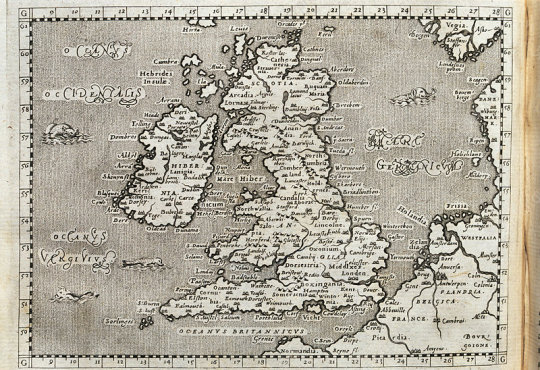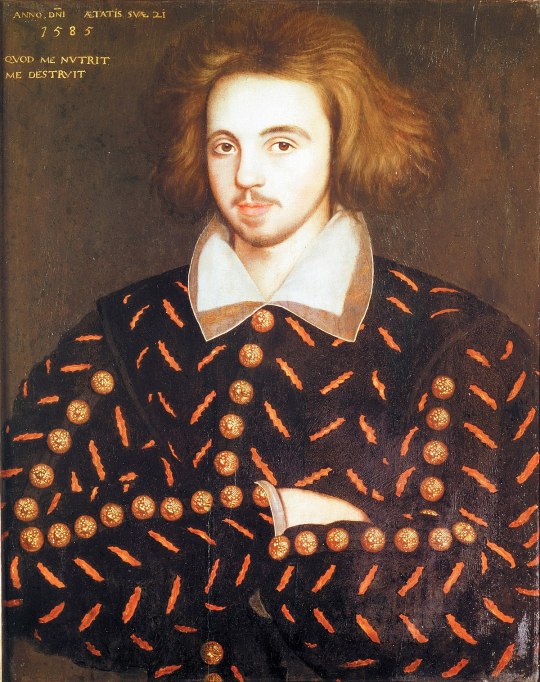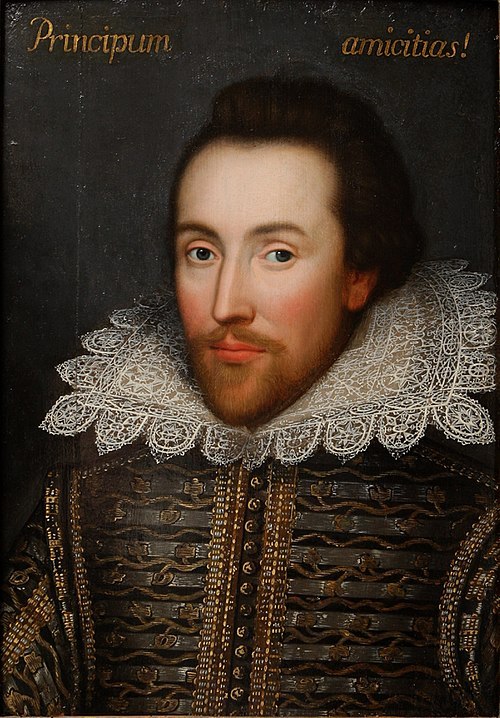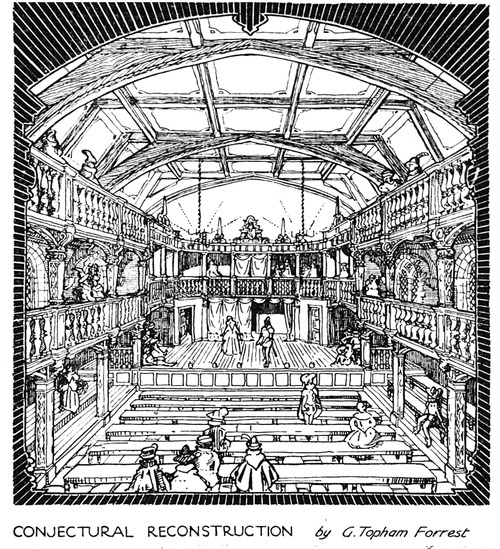This Tumblr is simply being used for educational purposes. I have created it for a class, however, I may end up continuing to inform people of theatre history using this page.
Don't wanna be here? Send us removal request.
Text
English / Elizabethan Renaissance

Image by George Bernard via Science Photo Library
Background
*Note: for accuracy, the sections will be labeled as Elizabethan rather than English as the period is defined by Elizabeth I's influence on England.
Secularization (converting to a new religion) began when Henry VIII tried to get his marriage to Catherine of Argon annulled to marry Anne Boleyn.
His daughter Mary (the daughter of Henry and Catherine) became queen and attempted to reinstate Catholicism.
She became known as "Bloody Mary" for burning 280 Protestants for refusing to convert to Catholicism.
Elizabeth I was crowned Queen of England after Mary's death in 1558.
Elizabeth strengthened the Anglican Church
With the execution of her cousin, Mary, Queen of Scots, she ended the Catholic claim to the throne.
England had also defeated the Spanish Armada.
Thomas More's Utopia was a landmark of the early Elizabethan Renaissance.
Interludes- brief dramatic entertainments written and staged by professionals
They were presented at court and in the homes of the nobility.

Image of the Globe Theatre by Dorling Kindersley via DKFindOut!
Elizabethan Drama
Categorized by Seneca's revenge-obsessed characters, his presentation of violence on stage, and his use of supernatural beings.
Drama in England followed an Episodic structure
a series of episodes all connected but perhaps out of chronological sequence.
English playwrights went against neoclassical ideals set by Italy
art should express the ideal virtues in life and could improve the viewer by imparting a moralizing message
Five basic rules were established: form purity, five acts, verisimilitude or realism, decorum, and purpose.
Verisimilitude: having reality/truth concerning the play
Decorum: appropriate speech or acting of a character
The neutral platform stage had evolved to the point that was ideal for plays.

Anonymous portrait via Wikipedia
Christopher Marlowe (1564-1593)
focused on dramatic poetry
Under Marlowe, Iambic Pentameter developed strength, subtly, and suppleness.
Iambic Pentameter: a line of verse with five metrical feet, each consisting of one short (or unstressed) syllable followed by one long (or stressed) syllable
Perfected the chronicle play
history play that emphasizes important public issues
Marlowe's verse and subject matter influenced Shakespeare
One of his most popular surviving works is Doctor Faustus
youtube
Doctor Faustus performed by the Oxford Theatre Guild

The Cobb Portrait via Wikipedia
William Shakespeare (1564-1616)
Took Senecan devices: episodic structure, the platform stage, powerful dramatic verse and stories from English and Roman history, Roman drama, and Italian literature.
By 1590, he was in London, working as an actor and a playwright.
His verse—especially in the power of his metaphors and the music of his language— is extraordinary.
His characters are so well-rounded and carefully detailed that they often seem like living people.
He excelled in tragedies, comedies, histories, and other dramas that are difficult to categorize (sometimes problem plays)
Shakespeare uses episodic structure to create a forceful, imaginative drama that has its own dynamics
youtube
Antony and Cleopatra by William Shakespeare performed by Unbound Theatre

Image of Blackfriars Theatre by G. Topham Forrest via Wikipedia
Elizabethan Theatres
Referred to as public and private, outdoor and indoor, or amphitheater and hall playhouses.
The larger theatres as the Globe and the Fortune, were open to the sky in their central area.
They accommodated more people and charged less for admission than the smaller indoor/ hall theatres, which were private.
The public theatres were built outside the city limits of London, to the north or south of the city across the Thames River.
The London City fathers opposed theatres on moral grounds and forbade them in the city.
Outdoor theatres were a platform stage about 4 ft high that thrust into the audience.
Outdoor theatres were a neuter stage.
The audience capacity was 1,500-3,000 spectators.
On the ground floor, in front of and on the sides of the stage, was a standing area known as the yard.
The lower-class spectators who stood there were called groundlings.
The stage was a raised platform surrounded on 3 sides by the audience
It was closer to a contemporary thrust stage than to a proscenium arch stage

Image via Pinterest
The tiring house was probably a three-story building that served as a place for changing costumes and storing props and set pieces.
Its facade was the basic scenic element in the Elizabethan public theatres.
Exits into the tiring house and entrances from it indicated a scene change.
Musician's Gallery
The third level of the tiring house probably housed about 6 musicians who provided accompaniment for the plays.
Heavens or shadows
A roof extending from the tiring house protected the stage.
Supported by pillars on some theatres and was suspended from the back for others.
The underside of the roof was often painted to literally represent the heavens.
From the opening of the first private/indoor theatre, the Blackfriars Theatre, in 1576 until about 1608:
These theatres were used exclusively by the popular boys' companies
private theatres sat about 600-750 spectators
were often lit by candles and had high windows
The pit of a private theatre faced the stage in only one direction and had backless benches.
The platform stage probably extended to the side walls.
Galleries and boxes faced the stage on 3 sides.
During the Jacobean period, wealthy audience members could sit on the stage.
Works Consulted:
Wilson, Edwin, and Alvin Goldfarb. Living Theatre: A History of Theatre. W.W. Norton & Company, 2018.
#Youtube#elizabethan england#elizabeth the first#henry the eighth#shakespeare#theatres#the globe theatre#the blackfriars theatre
3 notes
·
View notes
Text
Italian Renaissance Theatre

Image by Fashion and Art via Pinterest
Background
Niccolo Machiavelli outlined in his work The Prince that rulers must protect their subjects no matter what- even if it is unethical.
The merchant class gained more money during the Renaissance
The De Medicis family in Florence gave financial support to artists
Humanism began to spread across the country
The concept focused on people rather than gods.
Dante Alighieri (1265-1321)
Wrote The Divine Comedy, which was written in the vernacular (Italian) instead of Latin
In the mid-15th century, Johannes Gutenberg made literature available with the printing press.
People like Galileo, Copernicus, and Kepler demystified the cosmos.

Painting by Isabella Andreini via World4.eu
Dramas / Genres
Tragedies and Comedies
Sacra rappresentazioni (Sacred Representations) developed in the 1300s and 1400s
religious dramas in the medieval style
Eccerinus by Alberino Mussato is often cited as the first tragedy of the Renaissance.
Achilles by Antonio Laschi is also noted as the earliest Renaissance tragedy
The renewal of interest in classical dramatic traditions was inspired by several developments:
A revival of the teaching of Greek close to the end of the 1300s
a transfer in 1453 of surviving Greek and Roman manuscripts after the fall of *Constantinople.
the publication of all the extinct plays attributed to Aeschylus, Sophocles, Euripides, Aristophanes, Plautus, Terence, and Seneca
the dissemination of the writings of Aristotle and Horace
*Note: Constantinople had been the center of the eastern Roman empire
Intermezzi and Pastorals
Intermezzi were short pieces depicting mythological tales
Presented between the acts of full-length plays
required spectacular scenic effects
Pastorals were short, ribald comic pieces that had been presented as a follow-up to Greek tragedies.
the subject matter is romance
Not overtly bawdy or sexual in style or subject matter
Opera
Developed at a Florentine academy at the end of the 16th century
Earliest works based on Greek Mythology
Considered a form of music because it is completely sung
Aria- a solo song accompanied by the orchestra
Recitative- sung dialogue
Wolfgang Amadeus Mozart (1756-1791) is considered the greatest 18th-century opera composer.
Commedia dell'arte
Italian for "play of professional artists"
Commedia companies usually consist of 10 performers, 7 men, and 3 women
mainly associated with comedy
Scenarios- short scripts without dialogue
Commedia characters used lazzi (bits of physical comic business)
Zaibaldoni- manuscripts that contain jokes, comic business, and repeated scenes and speeches

Image via CulturalHertitageOnline
Theatre Architecture
Teatro Olimpico
Oldest surviving theatre constructed during the Italian Renaissance
Premier production was Sophocles Oedipus the King
youtube
Designed as a miniature indoor Roman theatre
Sat 3,000 spectators
Had a raised stage
The facade of the scene house was meant to look like a street.
Theatre at Sabbioneta
Had 250 seats
Erected for the Academia de Confidenti
Teatro Farnese and the Proscenium Stage
Built into the Great Hall of the Palazzo Della Piolotta
Had horseshoe seating
Fit 3,500 spectators
Had the first proscenium arch stage
Could have had a temporary arch and added a permanent one later

Image via italianrenaissancetheatre
Perspective in Scene Design
Perspective gave depth to a stage
Sebastian Serlio
Introduced perspective and have 3 basic settings
a tragic setting: showing a street or stately house
a comic setting: showing a common street scene
a pastoral setting: showing trees, hills, and cottages
Used angled wings
Flats hinged in a fixed position and painted in perspective.
The back of the stage was raked, meaning slightly raised
Advances
Note: The angle-wing setting was virtually impossible to shift scenes
The flat wing was introduced
A series of individual wings on each side of the stage
Enclosed at the very back by two shutters that met in the middle
Groove System
The earliest method of scene shifting for flat-wing setting
Wings and shutters were placed in grooves in and above the stage floor
The grooves allowed these elements to slide offstage easily and quickly so that a new series of wings and shutters could be immediately revealed to the audience.
Torelli
Nicknamed "the Great Wizard"
Pole and Chariot System
Poles were attached to scene flats that went below the stage floor, where they connected to wheels.
The chariots were wheels that ran in tracks.
Flats were moved offstage smoothly with a series of connected ropes and pulleys.
An entire set of flat wings could be removed simultaneously by turning a single winch
one set could almost dissolve into another
Special Effects
Glories- flying machines
trapdoors
primitive sound-effect devices to simulate thunder and wind
Works Consulted:
Wilson, Edwin, and Alvin Goldfarb. Living Theatre: A History of Theatre. W.W. Norton & Company, 2018.
2 notes
·
View notes
Text
Roman Theatre History

Image by Grant McCollor Via Flickr
Background
Rome was founded around 750 BCE.
The Romans were separated into different classes.
The Patricians, the rich upper class, the Plebians, the ordinary citizens, and lastly, the slaves.
During the Punic Wars, Carthage tried to take over Rome and lost, ending in the destruction of Carthage.
Romans developed aqueducts and roadways that are still used today.
Most modern European highways are built on top of Roman roads.
In the 1st Century, Rome began to show signs of strain.
There was too much territory that was far away from the city of Rome.
The murder of Julius Caesar also started the end of the Roman Empire.
Rome also held festivals, one being The Lundi Romani held in September.
250 to 150 BCE Rome came into contact with Greece.
Romans did not invent any new form of theatre besides architecture, and instead built off of the Greeks.

Image from Capitoline Museum via World History Encyclopedia
Genres
Comedy
Fabula togata- plays dealing with Roman issues
Fabula Palliata- plays based off of Greek Models
Romans eliminated the chorus altogether
Added musical accompaniment
Plays emphasized eavesdropping
The setting of action was usually on a street
Comedy was more popular than tragedy in Rome
Pantomime stemmed from comedy
Tragedy
Fabula Crepidata- adapted from Greek works
Fabula Praetexta- had Roman storylines

Image from Wikipedia
Playwrights
Comedic Playwrights
Plautus
Lived 254 to 184 BCE
Did not include a chorus
Did not deal with political or social issues
Depicts trials and tribulations of romance
Modeled modern musical comedies
Terence (pictured above)
Lived 185 to 159 BCE
Stressed characterization and subtlety of expression
Used the prologue to include background information of the play
First major black playwright in Western Theatre
Had better plot that was carefully constructed
Tragic Playwrights
*Quintus Ennius (239-169 BCE)
*Marcus Pacuvivus (220-130 BCE)
*Lucius Accius (170-86 BCE)
*Note: playwrights listed have no surviving plays and fell out of favor. Not much is known about them.
Seneca
Lived 4 BCE to 65 CE
May has served as a tutor for Emperor Nero
Studied literary criticism
Caligula exiled Seneca for 2 years for his impressive oratorical skills
His work was similar to Greek tragedies
Emphasizes a violent spectacle
His works had 5 episodes separated by a choral ode.

Image from Amadscientist via Ancient History Blog
Theatre Buildings and Scenic Elements
Theatre of Pompey (55 BCE)
First permanent theatre
Cavea= Greek Theatron (audience seating)
Orchestra- Semi circular
The Orchestra was not used for the stage but for the seating of government officials.
Scaena- skene/scene house
Pulpitum- A raised stage 5 feet high sat in front of the scaena and was the length of a football field.
Vomitoria- passageways that came under the seating area and led to the stage and orchestra
Theatres were freestanding structures not built into hillsides
Could hold up to 25,000 spectators
Awnings were set up, and fans blew over cooled water for air conditioning
Used Curtains
Aleum- Front curtain which was raised and lowered in front of the stage
Aleum was used to conceal actors
Siparium- a painted backdrop
Works Consulted: Wilson, Edwin, and Alvin Goldfarb. Living Theatre: A History of Theatre. W.W. Norton & Company, 2018.
1 note
·
View note
Text
Greek Theatre History

Image from National Geographic Via 6gradeschool
Background:
Greece gave way to the birth of western theatre. There were influences from Minoan culture and Mycenaean culture.
Minoan influences included agriculture and architecture. Mycenaean culture also had architecture, and the Mycenaeans were the first Greeks.
Athens became the center of the Greek world and was the place of the Theatre of Dionysius.
Festivals were used to honor the god of wine, fertility, and revelry, where a drama form called dithyramb originated.
A harpist and poet named Arion perfected dithyramb.
Dithyramb: A long hymn, sung and danced by a group of fifty men. Its format may have been similar to that of a modern-day choral presentation.
An actor named Thespis (where the phrase thespian originates from) is said to have transformed the dithyramb into tragedy. However, the Greek word for an actor was hypokrite which literally meant answerer.

Image via pickyourtrails
Festivals:
The most important festival for the Greeks was called The City of Dionysia, which honored Dionysus.
It was held in Athens at the end of March around when spring arrived.
tragedy was incorporated in 534 BCE
comedy, and satire plays were added in 436 BCE
The festival lasted for several days and began with a Proagon, which was a preliminary presentation.
The Archon was a government official who chose the plays and then assigned a Choregoi to be the producer.
Parades and sacrifices honored Dionysus.
5 days were assigned to dithyrambs and plays
For 2 days, 10 dithyrambic choruses were presented.
1 day assigned to chorus made of men and another day assigned to choruses made of boys.
3 allotted days for tragedies and satyr plays
This made a tetralogy, which was 3 tragic plays and 1 satyr play

Image via famous authors
PLAYWRIGHTS/ACTORS
Aeschylus
lived from 525 to 456 BCE
He was the first to develop drama into a form separate from singing, dancing, or storytelling.
Founder of Greek Drama
Excelled in the tetralogy form of plays.
He utilized the chorus the most in his plays and added a second actor to the stage.
He also reduced the chorus number from 50 to 12.
Sophocles
He lived from 496 to 406 BCE.
He examined characters further and gave them more characteristics.
Acted in his own plays.
Defeated Aeschylus in the City of Dionysia contest in 468 BCE.
He introduced a third character to his plays, and some of his surviving plays are Oedipus the King, Antigone, and Oedipus at Colonus.
Euripides
He lived from 480 to 406 BCE.
He is considered the most modern playwright.
He had a sympathetic portrayal of women and also used realism, tragedy, melodrama and a comedic mix.
Within his plays, he also had a skeptical treatment of gods and heroes. One of his surviving plays includes Medea.
THEATER BUILDINGS
The ampithetres could typically accommodate 15,000 to 17,000 spectators.
The theatres relied on natural lighting, and tended to be built into hillsides with good acoustics.
Architecture
Theatron= the seating area
seating area had wooden benches that were replaced with stone during Hellenstic period.
Men and women also sat separately
Proedria(front row) was reserved for political and religious dignitaries
Orchestra was used for the actors, not seating or music.
Circular orchestra may have been a Hellenistic invention
Skene= scene building
Skene served as the basic settings for all plays
Pinake- a type of flat, which was a wooden frame covered with a stretched fabric
Periaktoi- a triangular stage device consisting of 3 painted flats hinged together, each show a difference scene
Rotating these flats revealed one new scene to the audience, while hiding the other two

Image by Lauracomonias via Wikipedia
The mechane was a crane hidden behind the upper level of the skene.
Also called Deus ex machina, meaning "god from the machines."
This device was used as the entrance for gods or goddesses
Works Consulted:
Wilson, Edwin, and Alvin Goldfarb. Living Theatre: A History of Theatre. W.W. Norton & Company, 2018.
17 notes
·
View notes